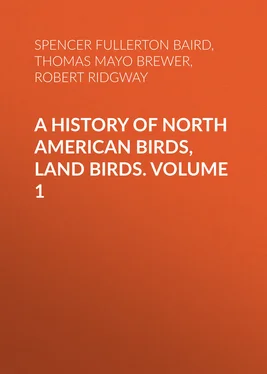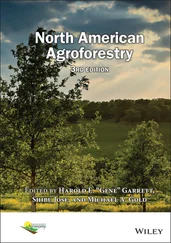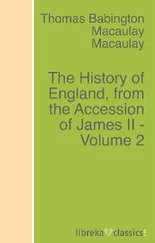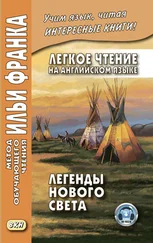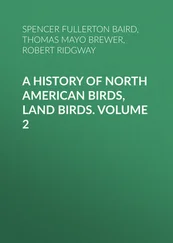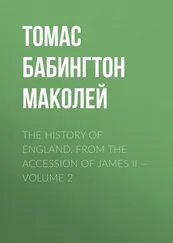Robert Ridgway - A History of North American Birds, Land Birds. Volume 1
Здесь есть возможность читать онлайн «Robert Ridgway - A History of North American Birds, Land Birds. Volume 1» — ознакомительный отрывок электронной книги совершенно бесплатно, а после прочтения отрывка купить полную версию. В некоторых случаях можно слушать аудио, скачать через торрент в формате fb2 и присутствует краткое содержание. Жанр: foreign_antique, Биология, foreign_edu, на английском языке. Описание произведения, (предисловие) а так же отзывы посетителей доступны на портале библиотеки ЛибКат.
- Название:A History of North American Birds, Land Birds. Volume 1
- Автор:
- Жанр:
- Год:неизвестен
- ISBN:нет данных
- Рейтинг книги:3 / 5. Голосов: 1
-
Избранное:Добавить в избранное
- Отзывы:
-
Ваша оценка:
- 60
- 1
- 2
- 3
- 4
- 5
A History of North American Birds, Land Birds. Volume 1: краткое содержание, описание и аннотация
Предлагаем к чтению аннотацию, описание, краткое содержание или предисловие (зависит от того, что написал сам автор книги «A History of North American Birds, Land Birds. Volume 1»). Если вы не нашли необходимую информацию о книге — напишите в комментариях, мы постараемся отыскать её.
A History of North American Birds, Land Birds. Volume 1 — читать онлайн ознакомительный отрывок
Ниже представлен текст книги, разбитый по страницам. Система сохранения места последней прочитанной страницы, позволяет с удобством читать онлайн бесплатно книгу «A History of North American Birds, Land Birds. Volume 1», без необходимости каждый раз заново искать на чём Вы остановились. Поставьте закладку, и сможете в любой момент перейти на страницу, на которой закончили чтение.
Интервал:
Закладка:
Dr. Cooper states that these thrushes sing most in the early morning and in the evening, when numbers may be heard answering one another on all sides. They do not affect the darkest thickets so much as the Hermit Thrush, but are often seen feeding in the gardens in the open sunshine.
Dr. Suckley, who found them quite abundant in the neighborhood of Fort Steilacoom, on the edge of the forest, and in swampy land, describes the song as a low, soft, sad, and lively whistle, confined to one note, and repeated at regular intervals. Mr. Nuttall, the first to describe this form, speaks of it as shy and retiring, and as in the habit of gathering insects from the ground. His ear, so quick to appreciate the characteristics of the songs of birds, which showed a close resemblance between the notes of this bird and that of Wilson’s Thrush ( T. fuscescens ), enabled him to detect very distinct and easily recognizable differences. It is much more interrupted and is not so prolonged. The warble of this bird he describes as resembling wit-wit t´villia , and wit-wit, t´villia-t´villia . His call when surprised was wit-wit .
All the nests of this species that have fallen under my observation are large, compact, strongly constructed, and neat. They measure about 5 inches in their external diameter, with a depth externally of 3; the cavity is comparatively shallow, being rarely 2 inches in depth. The external portions are constructed almost entirely of Hypnum mosses, matted together and sparingly interwoven with dry leaves and fine fibrous roots, and are lined with finer materials of the same kind. These nests most nearly resemble in their material and in their position those of Swainson’s Thrush.
Mr. Hepburn found these birds very abundant about Victoria. It does not usually breed there before the last of May, though in one exceptional instance he found a nest with young birds on the 24th of that month.
The eggs vary in size and shape, ranging from .77 to .94 in length, and from .65 to .69 in breadth. They also vary in their ground color and in the tints of the spots and markings. The ground color is light green or light blue, and the markings are variously yellowish-brown and lilac, or dark brown and slate.
Mr. Grayson found this thrush very abundant in the month of January, in the thickest of the woods, in the islands of the Three Marias, on the Pacific coast of Mexico. They were very timid and shy, more so than any bird that he saw on those islands. It frequently uttered a low plaintive whistle, and seemed solitary in its habits.
Turdus pallasii , Cabanis, Wiegmann’s Archiv, 1847 (I), 205.—Baird, Birds N. Am. 1858, 212.—Ib. Rev. Am. B. 1864, 14.—Sclater, P. Z. S. 1859, 325 ??.—Ib. Catal. 1861, 2, No. 7.—Ridgway.—Maynard.—Samuels, 148. Turdus solitarius , Wilson, Amer. Orn. V, 1812, 95 (not of Linnæus).—Sclater, P. Z. S. 1857, 212. Turdus minor , Bon. Obs. Wilson, 1825, No. 72. Turdus guttatus , Cabanis, Tschudi, Fauna Peruana, 1844, 187 (not Muscicapa guttata of Pallas).
Additional figures: Aud. Birds Am. III, pl. cxlvi.—Ib. Orn. Biog. I, pl. lviii.
Sp. Char. Tail slightly emarginate. Above light olive-brown, with a scarcely perceptible shade of reddish, passing, however, into decided rufous on the rump, upper tail-coverts, and tail, and to a less degree on the outer surface of the wings. Beneath white, with a scarcely appreciable shade of pale buff across the fore part of the breast, and sometimes on the throat; the sides of the throat and the fore part of the breast with rather sharply defined subtriangular spots of dark olive-brown; the sides of the breast with paler and less distinct spots of the same. Sides of the body under the wings of a paler shade than the back. A whitish ring round the eye; ear-coverts very obscurely streaked with paler. Length, 7.50 inches; wing, 3.84; tail, 3.25; tarsus, 1.16; No. 2,092.
Hab. Eastern North America. Mexico? Not found in Cuba, fide Gundlach.
In spring the olive above is very much that of eastern specimens of swainsoni ; in winter specimens it is much browner, and almost as much so as in fuscescens . Young birds have the feathers of the head, back, and wing coverts streaked centrally with drop-shaped spots of rusty yellowish.
Habits. Until quite recently the “Ground Swamp Robin,” or Hermit Thrush, has not been distinguished from the closely allied species T. swainsoni , and all accounts of writers have blended both in singular confusion. My colleague, Professor Baird, in the summer of 1844, was the first to suggest the distinctness of the two species. By the common people of Maine and the British Provinces this difference has long been generally recognized, this species being known as the “Ground Swamp Robin,” and the other as the “Swamp Robin.”
The present species is found throughout Eastern North America to the Mississippi, and breeds from Massachusetts to high arctic regions. It is only occasionally found breeding so far south as Massachusetts; through which State it passes in its spring migrations, sometimes as early as the 10th of April; usually reaching Calais, Maine, by the 15th of the same month.
It is a very abundant bird throughout Maine, where it begins to breed during the last week of May, and where it also probably has two broods in a season.
The greater number appear to pass the winter in the Southern States; it being common in Florida, and even occasionally seen during that season as far north as latitude 38° in Southern Illinois, according to Mr. Ridgway.
It rarely, if ever, sings during its migrations; appears in small straggling companies, frequents both thickets and open fields, and is unsuspicious and easily approached.
The song of this species is very fine, having many of the characteristics of that of the Wood Thrush ( T. mustelinus ). It is as sweet, has the same tinkling sounds, as of a bell, but is neither so powerful nor so prolonged, and rises more rapidly in its intonations. It begins with low, sweet notes, and ends abruptly with its highest, sharp ringing notes.
Taken from the nest they are easily tamed, and are quite lively and playful; but their want of cleanliness renders them very undesirable pets. When their nest is visited they make no complaints, but retire to a distance. Not so, however, when their natural enemy, the hawk, appears; these they at once assail and seek to drive away, uttering loud and clear chirps, and peculiar twittering sounds.
The nest of this thrush is always built on the ground, most generally either under low bushes or in the open ground, rarely, if ever, among thick trees, and for the most part in low swampy places. Both nest and eggs closely resemble those of Wilson’s Thrush ( T. fuscescens ). In Parsboro, Nova Scotia, I found one of the nests built in the very midst of the village, close to a dwelling, though on a spot so marshy as to be almost unapproachable. The nests are 3 inches in height and 5 in diameter, with a cavity 3¼ inches wide by 1¾ deep. They are composed of decayed deciduous leaves, remnants of dried plants, sedges and grasses, intermingled with twigs, and lined with finer grasses, sedges, and strips of bark.
The eggs are of a uniform bluish-green color, and range in length from .88 to .94, with an average of .63 of an inch.
Turdus nanus , Aud. Orn. Biog. V, 1839, 201, pl. cci.—Baird, Birds N. A. 1858, 213; Rev. Am. B. 1864, 15.—Sclater, P. Z. S. 1859.—Ib. Catal. 1861.—Dall & Bannister.—Cooper, Birds Cal., p. 4. Turdus pallasi , var. nanus , Ridgway, Rep. Kings Exped. V, 1872. ? Turdus aonalaschkæ , Gmelin, S. N. I, 1788, 808. ?? Muscicapa guttata , Pallas, Zoög. Rosso-Asiat. II, 1811, 465.
Читать дальшеИнтервал:
Закладка:
Похожие книги на «A History of North American Birds, Land Birds. Volume 1»
Представляем Вашему вниманию похожие книги на «A History of North American Birds, Land Birds. Volume 1» списком для выбора. Мы отобрали схожую по названию и смыслу литературу в надежде предоставить читателям больше вариантов отыскать новые, интересные, ещё непрочитанные произведения.
Обсуждение, отзывы о книге «A History of North American Birds, Land Birds. Volume 1» и просто собственные мнения читателей. Оставьте ваши комментарии, напишите, что Вы думаете о произведении, его смысле или главных героях. Укажите что конкретно понравилось, а что нет, и почему Вы так считаете.
